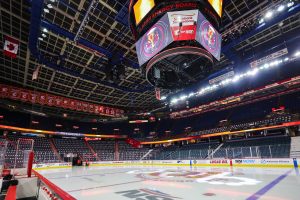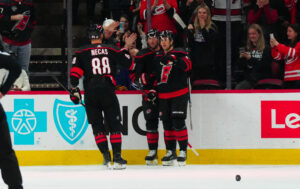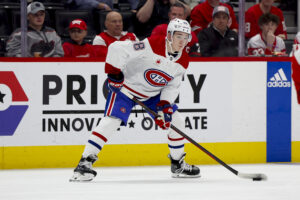As the San Jose Sharks‘ 2021 season approaches, we’ll start by reviewing some important offseason moves. There were not a lot of major moves, but one retained player raised eyebrows. Or rather, the contract raised eyebrows. The team signed restricted free agent Kevin Labanc to a four-season deal at $4.725 million per season. There was plenty questioning the deal, though some did come to the defence of it. It is 50% higher than one prominent consultant estimated.
I’ve looked at the deal in a variety of ways and I can’t justify it. Or really, even come close to justifying it.
The Kevin Labanc Contract Is Indefensible
Pros and Cons
I’ll start by looking at the pros and cons of Kevin Labanc.
The list of pros is notable. Labanc is a contributor on the power play, an important part of most successful teams. He is among the team’s best passing forwards, on a team with a shortage of these. The team is also short of right-shot forwards; Labanc is the lone NHL proven right-shot forward on the Sharks roster. He does have some finishing ability and despite his modest size, he’s proven durable. Labanc, who’ll soon turn 25, is also a younger player, while the Sharks’ top talent skews considerably older. There’s reason to believe he’ll have some of his best seasons in the upcoming years.
The con side is another lengthy list. Though some will cite his Corsi numbers as driving play, the eye test (at least my eye test) doesn’t agree. Nor has he shown an ability to carry a line, not even a lower line. His even-strength scoring is modest and he’s a defensive liability. Yes, he is young, but not that young. Not only is his defence troubling, but he spends too much time in the penalty box. He is of no value on the penalty kill and his forechecking is, and I’m being kind here, limited. While it is no longer a shock when he wins a puck battle, he isn’t winning very many.
Kevin Labanc’s Core Ability
I see Kevin Labanc with one important core ability. He’s a genuinely good offensive player if he has time and space. He can even create some time and space for himself, though he’s pretty vulnerable if a defender gets a body on him. This is central to the success he’s had. We’ve seen him use time and space to his advantage in two places, on Joe Thornton’s wing in the 2018-19 season and on the power play. In both these cases, he’s had time and space created for him.
Many will point to one number, his minus-33 line last season, and instantly react to that. We know plus-minus is often misleading and I’ll offer this. My eye test didn’t agree with this figure, but that doesn’t mean Kevin Labanc was good. Over the past two seasons, he spent a good bit of time on a line with Thornton and Marcus Sorensen. In 2018-19, Thornton and Sorensen scored 29 even-strength goals while Labanc had 15 of his own. In 2019-20, Labanc was down a bit, with 11 even-strength goals (on pace for 13 over a full 82 games season), but Thornton and Sorensen combined for just 10. Part of Labanc’s plus-minus issue was the decline in the goal-scoring of his linemates.
But it is also important to note that while Thornton was Labanc’s most common linemate in 2019-20, Sorensen was sixth. Thornton won’t be in San Jose next season, but Sorensen will.
The four forwards who were Labanc’s 2nd-5th most common linemates last season provide the crux of the story. Labanc is expected to become a top-6 forward, and those linemates are the core of the Sharks’ top six: Tomas Hertl, Logan Couture, Evander Kane and Timo Meier.
Looking at how Labanc fared with these forwards is key and as we’ll see, the ‘Labanc is a top-6 forward’ experiment failed last season.
The Data Points
Before proceeding, it’s helpful to offer some explanations for the upcoming data.
Corsi For % (CF%) is a value derived by looking at how many shots are generated while on offence compared to how many shots allowed while on defence. A CF% above 50% should portend good things, assuming shot quality is somewhat similar. Goals For % (GF%) is the percentage of goals scored by the team with a given player on the ice. This leads to a question, what if there is a big discrepancy between the two? And the answer is reasonably simple. There is a difference in quality between the shots taken and the shots allowed. In Labanc’s case, the difference is eye-popping, and not in a good way.
I’ll note most of the numbers come via nhl.com.
I looked at Labanc over two seasons (nominally a good one in 2018-19 and a not so good one in 2019-20) and focused my comparison on three former Sharks: defenceman Brenden Dillon, along with centers Chris Tierney and Barclay Goodrow.
Kevin Labanc Comparisons
The Sharks over the 2018-19 and 2019-20 season scored 313 5v5 goals and allowed 350, for a team GF% rate of 47.2%. With Labanc on the ice, the Sharks scored 44.6% of the goals. This despite the team’s CF% with Labanc on the ice at a stellar 55.5%. This gap is enormous and speaks to the difference in the quality of the Sharks offensive opportunities with Labanc on the ice compared to the ones given up defensively. To be blunt, it highlights the defensive liability Labanc represents.
Labanc’s deal is the sort of deal reserved for a player ‘who makes other players better’. But there is precious little evidence of this.
Over the 2018-19 and 2019-20 seasons, Labanc played over 200 minutes with seven Sharks forwards: Thornton, Sorensen, Goodrow, Kane, Meier, Hertl and Couture. He played under 200 minutes with Melker Karlsson, so he isn’t included in this comparison.
With two of the seven linemates, their GF% was better with Labanc on the ice than when he wasn’t. The two were Thornton (+5.4%) and Sorensen (+8.5%), driven by the trio’s strong 2018-19 season as the team’s third line.
Kevin Labanc and His Expected Role
Going forward, Labanc isn’t being paid for a third-line role. He’s the team’s fifth-highest paid forward and expected to slot in the top six. How did he do in that role? Abysmally.
The GF% was meaningfully worse for all five others when they played with Labanc, including all of the team’s top 4 forwards: Kane (-8.4%), Hertl (-5.5%), Couture (-9.2%) and Meier (-16.4%). Even Goodrow (-11.5%), who bounced among lines, was significantly worse with Labanc. In none of the cases was there a GF% above 50% (range 33.3% to 44.2%). In short, Labanc was given the role last season he is expected to fill this season. And with each one of his talented teammates, they were worse with Labanc on the ice.
What is both interesting and troubling, with all 7 forwards, their CF% was better with Labanc on the ice and in every case, above 50%. He is doing something which is good in theory, but ineffective in reality.
What we have here is a clear case of a player who is driving shots on the offensive side of the ice, but at a meaningful lower quality than the shots allowed on the defensive side.
The Kevin Labanc and Barclay Goodrow Comparison
How does Labanc stack up to Goodrow? Goodrow had five linemates who met the earlier 200-minute criteria, Labanc, Kane, Sorensen, Meier and Melker Karlsson. In three of the five cases, the difference in GF% was very marginally better (under 2%) with Goodrow on the ice compared to the same player without Goodrow on the ice. Goodrow’s GF% plummeted 10.8% with Labanc, while Hertl was +9.6% better without Goodrow (this was the duo with the smallest ice time together). In essence, Goodrow was close to a push, except with Labanc.
Over the two seasons, Goodrow had a 44.5% GF% and Labanc had a 44.6% GF%. This despite Goodrow’s top playing linemate (more than any two others) was the offensively-challenged Melker Karlsson.
Now we’ll get to the apples-to-apples scoring from last season. At 5-on-5, Labanc finished with 11G and 13A for 24 points. Goodrow had 8G and 13 A for 21 points, despite playing 8 fewer games (the result of his trade to Tampa Bay). There was a small difference in 5-on-5 ice time per game (13:37 for Labanc, 13:11 for Goodrow). In essence, their offensive productivity was nearly identical, despite Goodrow spending far less ice time with the Sharks’ top offensive players.
There are two other differences worth noting. Goodrow led all Sharks forwards in penalty kill minutes last season. Goodrow was the top forward on the league’s top PK% unit. In other words, he played a key role in the success of this unit. Labanc also played a key role on special teams, the Sharks PP. Which finished 23rd. Goodrow was a positive difference-maker on special teams, one can not make a similar case for Labanc.
Labanc and Goodrow, Power Plays and Penalties
The last area is the penalties. Though Goodrow had more penalty minutes (PIMs), what matters is how many times each player left the team short-handed. A meaningful part of Goodrow’s penalty time was ‘concurrent penalties’, that is two players left the ice at the same time, Goodrow and one from the opposing team. Over the past two seasons, the more physical Goodrow left the Sharks short-handed 27 times, Labanc 36 times.
Goodrow played center, a tougher and more valuable position than Labanc, who is a winger. Goodrow was second on the team in faceoffs, winning 49.2% of them.
Labanc played with superior teammates over the last two seasons but had a similar GF% in that time. Last season, Goodrow was a stalwart on the team’s brightest unit, the penalty kill. Labanc was a modest contributor to the team’s underachieving power play. In essence, Goodrow made something meaningful better. Labanc didn’t. Excluding each other, Labanc only appeared to make two players better, Thornton and Sorensen — and made five worse — including all of the top four Sharks forwards. Goodrow was a push in three cases, a detriment with one.
All in all, it is hard to make the case Labanc was a better or more valuable player than Goodrow.
The Kevin Labanc and Chris Tierney Comparison
Chris Tierney is another player Sharks fans are familiar with. He’s toiled the past two seasons for the Ottawa Senators, the league’s worst team in 2018-19 and second-worst in 2019-20. They’ve given up more goals than any team and are 22nd in goal scoring over the two seasons. Nonetheless, the 2019-20 season saw some improvement. Tierney, playing nearly identical 5v5 ice time as Labanc (18 seconds per game more for Tierney) for an offensively challenged team, managed to score more than Labanc. Tierney, like Labanc, a creative offensive player with a good passing game, tallied 6 goals and 24 assists for 30 points (Labanc was 11 and 13 for 24).
When it comes to penalties, Tierney took just 17 minor penalties over the past two seasons, compared to Labanc’s 36.
Like Goodrow, Tierney showed himself on special teams. He did little for Ottawa’s horrid power play but excelled on the penalty kill. Tierney managed 4 shorthanded goals (tied for 1st in the NHL) and 5 short-handed points (tied for 3rd), helping Ottawa to finish 4th in the league in short-handed scores. In other words. Tierney made a positive contribution to the penalty kill.
Tierney had more points (37) than Labanc (33), despite playing with lesser players and spending less than half of Labanc’s ice time on the power play. Like Goodrow, Tierney played center, leading the Sens in face-offs, winning 51.2%.
The Kevin Labanc and Brenden Dillon Comparison
Some might question the use of comparing a defenceman, Brenden Dillon here, but Dillon might be the most useful and important comparison of all. We noted earlier how Labanc suffered when looking at his GF% and how it dragged down all of the Sharks’ top forwards.
Dillon was the opposite. The left-shot defenceman made his right-shot partners better. This includes Brent Burns and Erik Karlsson, arguably the team’s two most important players. And it wasn’t a little bit either. With Karlsson and Dillon, the GF% was a stellar 60.6%. Karlsson away from Dillon was 45.4%. The difference was just as stark with Burns, 61.1% with Dillon, 47.4% without him. And for the record, though their time together was modest, the Sharks third right-shot defenceman, Tim Heed, also had a better (albeit slightly) GF% with Dillon at 55%.
When it came to Corsi, Karlsson was better with Dillon (+5.5%), Burns a bit worse (-1.9%). Once again, we are looking at the quality of scoring chances and the disconnect between goal scoring and Corsi. With Labanc on the ice, goal-scoring strongly favoured the opponents. With Dillon, it strongly favoured the Sharks.
Three Kevin Labanc Comparisons
What is the key takeaway after all this? One is hard-pressed to find where Labanc made his teammates better in the area which matters most, what happens on the scoreboard.
We identified Goodrow and Tierney, scoring at a similar pace to Labanc. In practice, Tierney and Goodrow play center, a more demanding and more valuable position. Tierney re-signed for $3.5million per season while Goodrow has another season at $0.9million. Each player, individually was better than Labanc last season. But under his deal, Labanc will earn more than both players combined.
The most damning comparison is with Dillion. Dillon, whose new deal came in at $3.9million, is a player who makes the people around him better. He made the Sharks’ two most important players substantially better. This is the essence of value. But like the others, Dillon is getting less than Labanc. Indeed, the combined cap hit of Dillon and Goodrow is almost identical to Labanc’s alone.
Each of the compared players is making less than Labanc. Each was a better player last season. The two who played for the Sharks last season were not only better for the Sharks, but considerably more valuable.
One Fiction
When Labanc signed his team-friendly deal last season, the common interpretation was that Labanc was betting on himself. We can stop pretending. Some NHL observers believe Labanc had this new deal in his pocket when he signed a team-friendly deal in the 2019 offseason. He clearly didn’t earn his new deal with his 2019-20 play.
He also didn’t deliver a season consistent with a player fighting for a much bigger deal. There’s always a concern with a player’s motivation in a contract season. That they will be more motivated than in non-contract seasons. Labanc’s poor season, really a failed season should have earned him a much lesser deal. That has led others to conclude Sharks general manager Doug Wilson had given his word to Labanc and this deal was secured. Which doesn’t say much about Labanc’s ability to self-motivate.
The Kevin Labanc Power Play Argument
The positive argument for Labanc largely boils down to one thing, his power-play contribution in 2018-19. He was a major contributor on a successful team that season, totalling 20 power-play points in the regular season. And yes, those oh so memorable five minutes against the Vegas Golden Knights when he tallied four power play points.
Can I accord the Sharks power-play success in 2018-19 to Labanc? Or was it because the Sharks had an insane amount of firepower on their power-play units? I’ll go with the latter.
The Sharks power play included six forwards who’ve posted 30 goals seasons plus the top two scoring active defensemen in the entire league. Was Labanc simply a good fit who landed in a very good spot?
He was fifth in ice time on the man-advantage, making him an important contributor. In terms of goal differential/10 minutes of ice time, Labanc posted 1.25, a solid figure of merit, though seventh among the nine Sharks power play regulars.
Last season, the team’s power-play fell off. Labanc’s figure of merit fell to 0.83. Among the team’s eight players who dominated power-play ice time, Labanc was in what amounts to a four-way tie for fourth.
In his Sharks career, Labanc’s power-play contribution is the proverbial ship on the ocean, rising and lowering with the tide.
When Labanc played with an elite group of players in 2018-19, he fit in and kept up his end of the play. Last season, he also fit in, on an underachieving power play.
His four-point power play against the Vegas Golden Knights will live on. But that moment won’t repeat. In the other 19 playoff games that season, Labanc didn’t tally a single power-play point.
An Alternative Scenario
The Sharks now have the combination of Labanc, Devan Dubnyk and Ryan Donato, the latter two recently acquired from the Minnesota Wild. The total cap space for the trio is $8.8 million. Had the Sharks chosen to trade Labanc (I’ll assume for a second-round pick) and retain Aaron Dell (who had a much more respectable season than he’s been given credit for), they’d have two fewer players, but more draft picks and $8.725 million in cap space.
$8.0 million is what the Buffalo Sabres paid Taylor Hall, soon to be 29, an elite offensive player (exceeding a point per game 4 times) and a former winner of the Hart Trophy as the league’s MVP. Had the Sharks gotten Hall in the fold at the same figure, they’d have had a much better chance to retain Joe Thornton, who signed for a meagre $700,000 with the Toronto Maple Leafs.
Adding it up, Hall+Thornton+Dell is $9.5 million in cap space. Then add in a 2nd round pick (for Labanc), a third-round pick (used to acquire Donato), a fifth-round pick (used to acquire Dubnyk) and subtract a seventh-round pick (also in the Dubnyk trade). Contrast that with Donato+Dubnyk+Labanc at $8.725 million. The contrast is stark, almost to the point of absurd. And if Hall didn’t work out in San Jose this season and the team floundered, Wilson could flip him to a contender for more high-end draft picks.
If I’m going to paint my team into a salary cap corner, I’d rather do it with Taylor Hall talent than Kevin Labanc talent.
Summarizing the Kevin Labanc Deal
To sum up, Labanc’s even-strength offence isn’t particularly impressive. Yes, he does drive a nice CF%, but it doesn’t translate to the scoreboard. His defence, showing up in both GF% and penalties taken, is a distinct problem.
At the end of the day, I come back to the one central question. What does Labanc do which makes the team better? I could find an answer with Tierney. I could find an answer with Goodrow. With Dillon, not only could I find an answer, but it was a hugely important answer. But I couldn’t find an answer with Labanc.
Indeed, the specific players he is supposed to make better, the hard evidence says he’s made them worse. Labanc is being paid to be a top-6 player, but the Sharks’ top-six forwards he’s played with have a cumulative GF% of about 40% with Labanc on the ice and 50% without him.
To be blunt, I think Labanc and the Sharks would both be better off if he is gone. He could find a team that is a better fit, the Sharks could get something useful in return. I don’t see this happening. Not with this premium contract. Nor do I see Labanc fulfilling the Sharks’ expectations. Not with this premium contract.
In the end, there is no way I can defend the deal Labanc received. Just none.
Main Photo:
Embed from Getty Images






